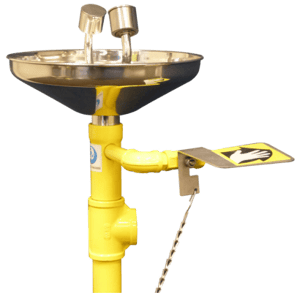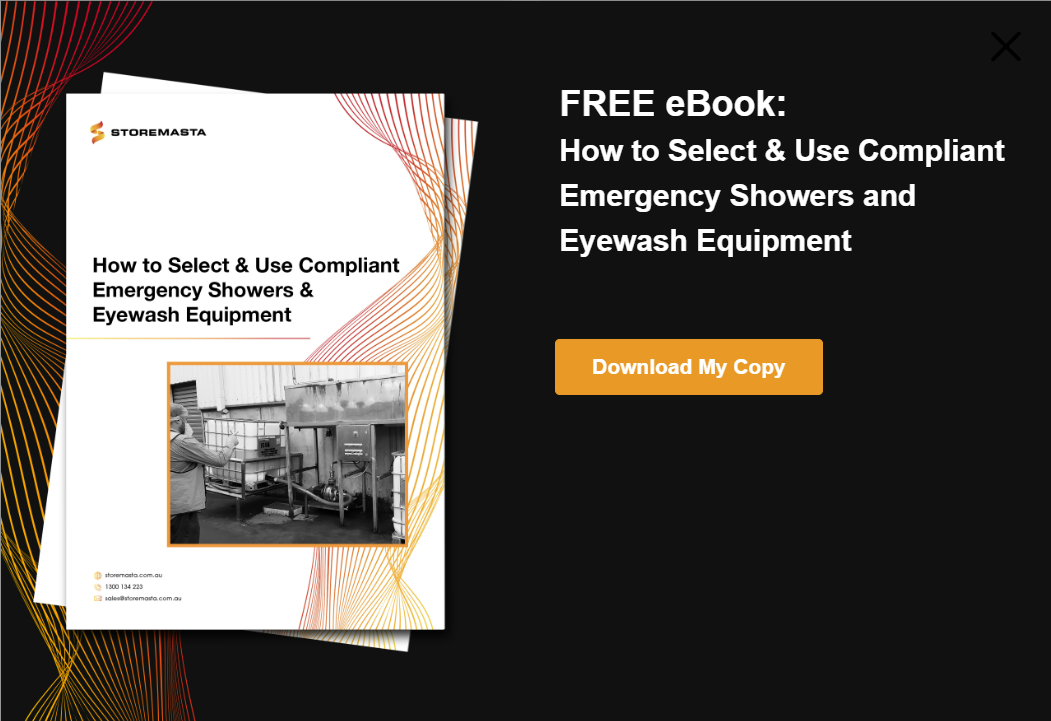Here at Storemasta, we often see emergency decontamination equipment fall into disrepair and non-compliance due to poor housekeeping practices. However, this can be easily prevented by training your staff to use and maintain safety showers and eyewash stations in the correct way. We’ll explain how to conduct staff training, so your safety showers and eyewash stations operate at an optimum level.
REMEMBER: Buying and installing emergency equipment is only one step in the safety process. Effective staff training and ongoing supervision is critical for all safety equipment.
How are Staff Trained in the Use of Emergency Equipment?
Safety shower and eyewash station training is essential for the safety of workers and the longevity of the equipment. There are many aspects to staff training, including considerations for awareness, emergency response, equipment testing, maintenance and housekeeping.
Training can be in many forms, with onsite training, group activities, simulations, video tutorials, online courses and instructor-led training all options that can assist organisations improve safety and awareness for their team members.
Awareness Training for Safety Showers & Eyewash Stations
Your training and induction program should begin with awareness training that focuses on identifying and locating the safety showers and eyewash stations. Your induction program might give workers an overall site plan which indicates the location of each decontamination station, but then narrows down into their individual work areas.

Eyewash station training should include procedures for emergency response.
Your awareness training will ensure that workers:
- Understand the hazardous chemicals or dangerous materials that could cause injuries.
- Can quickly locate the emergency decontamination equipment in their work area.
- Know what to do if they are injured by hazardous materials, fire, or chemical burns.
- Understand the different types of equipment and how to use it correctly (eyewash, showers, drench hoses, hand-held face wash)
- Are aware of other hazards in the area that could affect their safety.
Emergency Response Training
Emergency response training demonstrates to workers the exact procedures to follow if they (or co-workers) are exposed to hazardous materials or receive chemical burns. This training is most effective in one-on-one sessions where workers can practice using the equipment and following the full emergency procedure. The learning is then reinforced through simulated emergencies and drill responses.
The training program should cover at a minimum:
- Immediate responses: locating decontamination equipment, alerting co-workers, activating safety showers and eyewash stations, panic alarms, removing clothing and contact lenses.
- Treatment procedures: flushing times, holding eyes open with fingers, having co-workers put up privacy shields.
- Avoiding cross-contamination: positioning eyes and body, protecting first aiders, restricting access to the accident scene.
- Emergency responders: calling emergency services, granting access to ambulances and paramedics.
- Post care clean-up: disposal of contaminated clothing and wastewater, cleaning and testing the decontamination units.
- Possible interferences: not removing clothing, delaying response times, not staying in the shower long enough, using drench hoses incorrectly, trying to use a domestic hose instead of the eyewash, unconscious patients, bystanders.
Maintenance and Weekly Testing
What happens if a worker is sprayed with caustic liquid and the safety shower won’t work? It’s a requirement of Australian Safety Standards that plumbed emergency eyewash and safety showers are activated and tested at least once a week. But this won’t happen unless you train your managers and line supervisors, then put a system in place to make sure it’s always carried out.
An activation test is more than turning on a tap and seeing if water comes out. You’ll be visually appraising each unit and ensuring the area is free of obstructions and potential hazards.
We recommend the following safety shower and eyewash station testing considerations:
- Inspect pipework, shower-heads and connections ensuring there are no leaks, cracks, or structural damage.
- (Eyewash units) Check nozzle covers are clean and in position.
- Activate the unit and make sure paddle levers or pull handles work properly and water begins to flow immediately.
- (Eyewash units) Verify nozzle covers are automatically released and water flows from both nozzles.
- Evaluate the water pressure (in-line with manufacturer’s instructions) and the flow continues until manually shut down.
- Keep the water flowing long enough to clear the lines of any stagnant water, sediment and blockages.
- (Eyewash units) Check the nozzle covers return to their correct resting position once the water stops.
- Make sure water drains away correctly and bowls/grates are clean.
- Take a final check of the area: warning signs are in place, lights are working and area is well lit, supplementary equipment is in place (PPE, neutralisers, privacy screens, SDSs).
- Document the inspection, recording the date and name/s of the work team.
REMEMBER: You’ll need to ensure that enough workers/supervisors are trained to carry out the test, so the units are verified at least once a week.
Housekeeping and Proper Use
REAL-LIFE EXAMPLE: A lab worker in the US required emergency care after using an eyewash facility that had been contaminated. A co-worker had been using the eyewash taps to clean lab glassware and stainless-steel chemical trays, and the eye nozzles had become covered with cleaning agents.
To avoid situations like the above example, make sure that housekeeping practices are maintained —and the equipment is always being properly used.
Train your workers and contractors in the correct housekeeping and operational procedures, then provide enough supervision so they keep the emergency decontamination equipment clean and don’t misuse it.
Your weekly inspections should have triggers and corrective actions in place if staff are identified to be:
- Parking forklifts or vehicles (even temporarily) in the path of an eyewash/shower unit and workers.
- Obstructing the area with pallets, warehouse supplies, stationery, or personal items.
- Using showers or eyewash taps to wash hands, lunch containers, clothing, PPE, or work equipment.
- Bringing potentially hazardous materials into the area (eg, Class 4 Dangerous Goods).
REMEMBER: Even the most efficient and reliable worker will sometimes be tempted to use an eyewash or safety shower for washing hands and equipment if they must walk distances to access hand washing and cleaning bays. Position utility stations in practical areas that make it easy for workers to do the right thing.
Emergency Decontamination Done Right
For more information about selecting, installing, using, and maintaining safety equipment such as a safety shower and eyewash station, we’ve created a helpful guide. How to select and use compliant emergency showers and eyewash equipment is a free detailed compliance guide for busy HSE Managers or line supervisors with WHS responsibilities. By making sure your emergency decontamination equipment stays effective and compliant, you can successfully manage emergency situations – and decrease risk to your workforce. Grab your free eBook now to find out more about essential safety equipment.
Joining the team as a Dangerous Goods Storage Consultant, Melissa Hampton became Storemasta's Marketing Manager in late 2021. With extensive knowledge and experience in chemical compliance, Melissa is responsible for leading the Marketing team and helping shape their marketing strategy. In her spare time, you can find Melissa hiking, swimming and enjoying the great outdoors in beautiful north-west Tasmania.
